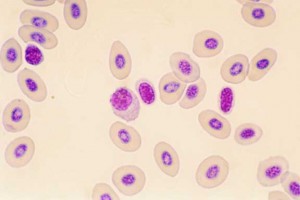Low blood platelets
Tuesday, October 4th, 2011 Blood cells are produced in the bone marrow. The three main components of blood are the red blood cells which carry oxygen, white blood cells or leukocytes which fight infection and platelets also called thrombocytes which assist in the formation of blood clot.
Blood cells are produced in the bone marrow. The three main components of blood are the red blood cells which carry oxygen, white blood cells or leukocytes which fight infection and platelets also called thrombocytes which assist in the formation of blood clot.
When a blood vessel is damaged platelets adhere to the surface of damaged vessel wall and release chemicals. The chemicals attract more platelets as well as red blood cells in order to form a clot or thrombus. As the clot grows the blood vessel narrows, thereby decreasing the blood loss. This process is called coagulation.
Normal platelet counts are in the range of 150, 000 to 350, 000 platelets per micro liter. Thrombocytopenia or low blood platelets are the disorders in which there are not enough platelets in the blood. When the platelet count is decreased the body is unable to form blood clots and is therefore unable to control the bleeding. Bruising and bleeding can occur from relatively little trauma. When the platelets count gets below 10, 000 platelets per micro liter, bleeding can develop even without significant trauma.
Chemotherapy induced thrombocytopenia is a disorder that develops as an adverse effect of chemotherapy. Cancer drugs not only kill cancer cells, they can also damage the platelet forming cells in the bone marrow. The severity of this disorder depends on the type of chemotherapy and the duration of treatment. Fortunately chemotherapy induced thrombocytopenia or low blood platelets can be managed with platelet transfusions, additional medications such as blood cell growth factors or with blood stem cell transplants.
Other common causes of thrombocytopenia or low blood platelets are ITP (immune thrombocytopenic purpura) and heparin induced thrombocytopenia. In immune thrombocytopenic purpura, anti platelet antibodies coat the platelets and destroy them, while heparin induced thrombocytopenia is caused by the formation of abnormal antibodies that activates platelets.
Impact-R has evolved as a blessing in disguise for the thrombocytopenia hit populations as it provides a very effective screening test for the timely detection of the patients suffering from thrombocytopenia. It has markedly decreased the morbidity and mortality associated with this disorder.